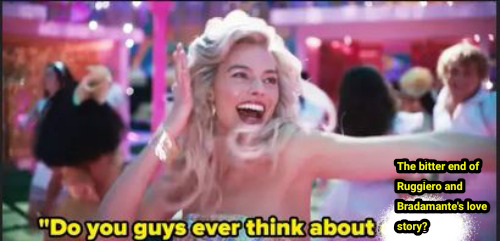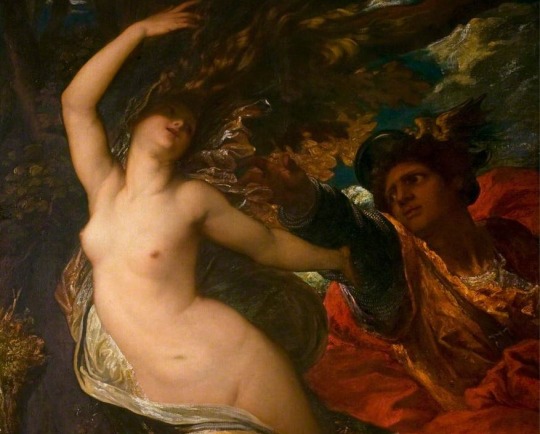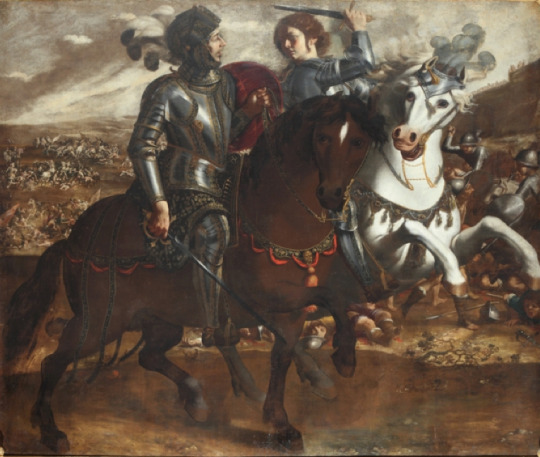#matteo maria boiardo
Text

Low quality meme for today's Orlandoposting
#italian literature#matteo maria boiardo#orlando innamorato#ludovico ariosto#orlando furioso#orlandoposting#ruggiero#bradamante#ruggiemante
52 notes
·
View notes
Text
Angelica (Orlando Innamorato): Bush or Bald?

It's rather vague whether Angelica is from India or China. This epic poem was written in Italy long before the invention of google earth, so the author probably didn't know the difference. It makes little difference for the purposes of this blog either, as both countries have strong bush traditions.
Verdict: bush
#angelica#orlando innamorato#matteo maria boiardo#princess pussy#bush#bushes of colour#did she have to ride that hippogriff pussy out?
1 note
·
View note
Text
Matteo Maria Boiardo | The Count frees the captives from the Ogre’s cave
And then he cried: ‘O Knight of the Lord,
As I must name you for your valiant deed,
To free the souls trapped in that abhorred
Villain’s cave, would, according to our creed,
Prove a noble work, and pious; rest assured.
I can guide you to the place, but, take heed,
Should we meet another giant, on the way,
Expect but little help from me, this day.’
So, the friar led Orlando to the…
View On WordPress
#Matteo Maria Boiardo#National Italian American Heritage Month#National Italian American Heritage Month 23#Poem#poet
0 notes
Text
Orlando Innamorato, Part 1
I have finished the first eight cantos of Orlando Innamorato, which brings us up to almost one hundred pages of A. S. Kline’s translation. That should put us well on track to finish the book before Easter on April 9th, which is our goal.
I think I made the right decision in buying this edition. Further checking has confirmed that Kline’s is one of only two complete translations of the Orlando…

View On WordPress
1 note
·
View note
Text

Herodoto Alicarnaseo historico Delle guerre de Greci et de Persi tradotto di Greco in lingua Italiana per il conte Matteo Maria Boiardo
[Herodotus, The Wars of the Greeks and the Persians, translated from Greek into Italian by Count Matteo Maria Boiardo]
Venice: Aldus Manutius [i.e. Aldine Press], 1502.
Matteo Maria Boiardo (1440-1494), Count of Scandiano, was Italian Renaissance poet, best known for his epic poem Orlando innamorato. His translation of Herodotus into Italian was the first complete translation of Herodotus into a vernacular language.
Source: https://www.publishinghistory.com/classical-greek-authors-aldine.html
18 notes
·
View notes
Text
HOLY SHIT THERE’S FINALLY AN EASY TO ACCESS TRANSLATION OF ORLANDO INNAMORATO
I am so happy about this (also it seems to have more poetry-like prose than the Charles Stanley Ross translation which I’m a big fan of)
25 notes
·
View notes
Text
UN PASTORE POETA | Berardino Perilli
A Campotosto (AQ) l'inverno si avvicina. Nel vento gelido dell'altopiano, il vecchio pastore Berardino Perilli si attarda con i suoi animali prima della transumanza verso la campagna ternana. Berardino ama Dante Alighieri e Matteo Maria Boiardo ...
Crediti: Fotogramma tratto dal documentario «Un pastore poeta», https://vimeo.com/190539261
A Campotosto (AQ) l’inverno si avvicina. Nel vento gelido dell’altopiano, il vecchio pastore Berardino Perilli si attarda con i suoi animali prima della transumanza verso la campagna ternana. Berardino ama Dante Alighieri e Matteo Maria Boiardo, legge l’Orlando Furioso e la Gerusalemme liberata, gioca con…

View On WordPress
1 note
·
View note
Link
I poemi cavallereschi È il genere letterario che va per la maggiore nel ‘500 Si ispira ai cicli bretoni e carolingi (storie di Re Artù e dei cavalieri della tavola rotonda o di Carlo Magno e dei suoi seguaci). STRUTTURA: sono dei poemi scritti in ottave, cioè in strofe di 8 versi ciascuna con schema di rime ABABABCC. I più famosi esempi di romanzi cavallereschi sono: àOrlando Innamorato di Matteo Maria Boiardo àOrlando Furioso di Ludovico Ariosto Gerusalemme liberata di Torquato Tasso
0 notes
Text
"festivaLOVE, è tutto pronto". Si parte alle 18 con la diretta streaming di Stefano Cappucci
Taglio del nastro alle 18 con la diretta streaming di Stefano Cappucci. Dalle 19 Elio, Carofiglio, Bartoletti, circo contemporaneo e molto altro
di Redazione Spettacoli
Tutto pronto a Scandiano per la sesta edizione di festivaLOVE, kermesse di tre giorni ospitata dalla città che diede i natali a Matteo Maria Boiardo, l’autore del poema epico e cavalleresco L’Orlando Innamorato. Un festival che, dal 17 al 19 giugno, animerà Scandiano dal tardo pomeriggio fino a tarda notte con appuntamenti di ogni genere, per tutti i target, e con grandi…

View On WordPress
0 notes
Text
Ok so ideologically I agree more with Boiardo but Ariosto has a better composition sense and character development. Also his poem actually ends. (Not) sorry
12 notes
·
View notes
Text

A me credete, miseri mortali,
credete a me, che ne ho verace prova,
che ogni vostro diletto è fumo al vento.
0 notes
Quote
Ne forte abbraccio, né ardire animoso,
Né scudo o maglia, né brando affilato,
Né altra possanza può mai far diffesa,
Che al fine non sia da Amor battuta e presa.
Matteo Maria Boiardo, Orlando innamorato, I, 1, ott. 2, frammento
54 notes
·
View notes
Photo


Apocalyptic Procession from The Divine Comedy & Orlando Furioso by Matteo Maria Boiardo illustrated by Gustave Doré 1879
Apocalyptic Procession by Gustave Doré
The passages of the Bible are represented as figures, twenty-four old men represent the Old Testament; followed by an empty chariot, which represents the church, drawn by a griffin, traditionally taken as a representation of Christ.
The empty chariot is symbolised by the empty juggernaut, the griffin represented by Shaw who has her ID tag discovered in the juggernaught/ in the book they discover her Cross and journal.
The chariot surrounded by seven female figures representing four cardinal virtues and the three theological virtues, as well as by four figures who represent the four evangelists.
In the city you can see 4 statues situated around the open hangar containing the other juggernauts.
Following behind are the Acts of the Apostles, the Epistles of Paul, and the minor Epistles of James, Peter, John, and Jude. Trailing behind is:
“a lone old man, his features keen, advanced, as if in sleep” (Purg. 29.143-44).
This is the author of the Apocalypse, John. He is in a visionary trance, “asleep”, yet keenly sighted.
I believe John is paralleled to Captain Jacob Branson who ironically says he is “Burning Up” before he dies in his hypersleep chamber.
Orlando Furioso by Gustave Doré 1879
The poem is a continuation of Matteo Maria Boiardo's Orlando Innamorato. Describing the journey of Charlemagne, the Franks and Orlando as they battle the Saracens. Ariosto composed the poem introducing narrative commentary and coining the term "humanism." Focusing on the strengths and potential of humanity, rather than only upon its role as subordinate to God. Leading to Renaissance humanism.
I believe this strongly represents the underlying themes of Prometheus and Alien: Covenant. Focus on humanity and strength of the characters in the face of God(Faith) and Satan(Everything that goes wrong) and Nothingness(Atheism) in the future.
Best viewed on desktop
Prometheus Analysis | Alien Covenant Analysis | Mythology Prequels Project | The Crossing Analysis | Advent Analysis
#Apocalyptic Procession#gustave dore#Orlando Furioso#Charlemagne#Matteo Maria Boiardo#the divine comedy#purgatory#dante alighieri#alien movie#alien film#alien covenant#alien: covenant#juggernaut#elizabeth shaw#jacob branson#space horror#science fiction#scifi horror#gothic horror#gothic romance#derelict#dreadnought#branson#covenant crew#uscss covenant#alien covenant analysis#film analysis#cinematography#Dariusz Wolski
37 notes
·
View notes
Note
May I ask what this Orlando Furioso thing is?
Orlando Furioso is the 1516 Epic Chivalric Romance Poem by Ludovico Ariosto, fanmade sequel to the unfinished 1483-1495 Epic Chivalric Romance Poem by Matteo Maria Boiardo, and its status as a sequel has displaced its predecessor in terms of mainstream awareness to such aggravating extents that it makes the popularity of Terminator 2 over Terminator 1 or Aliens over Alien look like potatoes so small they're downright microscopic.
There's a thing called The Matter of France which is a collection of legends, folktales, myths etc. about the French/Frankish King Charlemagne but more commonly about the knights (or Paladins) under his employ that are comparable to the French-Italian equivalent to King Arthurian myth. Only with *slightly* less exaggeration and mythification of actual documented historical figures.
It starts with the Song of Roland, based on an actual battle but exaggerated with artistic license to such extents that people consider it a propaganda piece for the Crusades (primarily because of how laughably inaccurate its description of Muslim belief is). People liked that so much that even in the late 1400s and early 1500s long after the Crusades petered out, the French and Italians wanted more of this Roland dude and his wacky adventures (even though he died in Song of Roland) so they started making up their own stories about him and various other OCs do not steal.
Orlando Innamorato and Orlando Furioso are probably the most well known parts of these myths aside from Song of Roland itself, which given how comparatively and unfortunately obscure they are outside of France and Italy, is a little like saying they're the tallest dwarfs in Snow White. Until Fate Grand Order happened and brought in Bradamante, Mandricardo and ESPECIALLY Astolfo, the closest you could probably get to a mainstream accessible way to experiencing the Poems was "Go to Italy, learn Italian and go watch a performance of the plays they made on it lmao."
As for what Furioso is about, like I said it's a sequel to Innamorato. Orlando Innamorato starts out with the titular Orlando (the Italian name for the aforementioned Roland) falling head over heels for beautiful Saracen (and possibly Chinese) Sorceress Angelica, who showed up one day at a tournament hosted by Charlemagne for the purpose of stirring up trouble and throwing the realm of Christendom into disarray by proclaiming anyone who defeats her totally-not-cheating-with-enchanted-weaponry-that-makes-him-unbeatable brother in combat can marry her. Because Angelica's the hottest bitch to ever walk the earth, pretty much everyone's lines up for a go, but shit happens when a giant crashes the party and kills her brother, sending everything into Chaos and kicking off a race between Orlando, his cousin and fellow paladin Rinaldo and a bunch of other knights to chase after the fleeing Angelica in hopes of winning her hand in marriage. And a bunch of OTHER SHIT with OTHER CHARACTERS happens along the way that would take too damn long to give a concise summary of even if I DID remember all of it!
The Furioso picks up where the unfinished Innamorato left off by having Angelica shack up, fall in love with, and marry some average Joe named Medoro, and Orlando, who had been chasing after in blind love (read: lust) the whole time, finds out about this and goes absolutely bugfuck insane (*Furioso* if you will) and strips off his armor and weapons (which get stolen for mcguffin purposes) and tears a path across Europe, North Africa and possibly Asia or the Middle East wrecking everyone and everything in his path until fellow Paladin Astolfo literally returns his wits to him after a trip to the moon (Long story).
Both poems I have semi-jokingly given the moniker of "Medieval Homestuck" due to the fact that there's a ton of characters that we follow for a while on their own little quests that we hop back and forth with in an increasingly elaborate tapestry of chronology like when they switch Viewpoints in Hussie's Webcomic. And also like Homestuck, there's lots of violence, death, and above all Romance.(there's even a Fountain of Love Potion right next to a fountain of HATE potion, which does exactly what you think it does when you drink it!)
There are more characters than I can name because it's been years since I read the Bulfinch Mythology version of the duology (because apparently Bulfinch had to chop out a lot of stuff to weld them together with other related Matter of France/Carolingian myths/Charlemagne Legends in order to try and fit them into a cohesive whole al a Le Morte d'Arthur) partially because I'm not Italian and I generally remember characters if I have a visual to associate them with, but here's some stand out examples:
-Rinaldo intermittently chasing Angelica due to the effects of a love potion and being repulsed by her due to the effects of a hate potion, and when he's not doing that he's lecturing people on unjust laws in towns he passes through.
-Astolfo minding his own business and traveling through the known world in total amazement and repeatedly switching between landing into trouble and solving other characters' problems by total accident.
-Angelica lamenting the death of her brother and running her ass away from EVERYONE just wanting to go home because she can't stand any of her potential suitors except this random schmuck who doesn't immediately try to jump her bones.
-Mandricardo attempting to avenge the death of his father at Orlando's hands only to wisely back out on that plan when Orlando goes berserk, so he settles on stealing Orlando's sword and horse to go on his own wacky adventures.
-Marfisa being a badass lady knight in the 1500s(!!!) and being solely motivated into fighting people for shits and giggles before gradually reasoning that Social Darwinism isn't actually all that cool.
-And my absolute FAVORITE of the myriad plotlines: The Romance between the OTHER Badass Lady Knight Bradamante(!!!) and her boyfriend the Saracen Himbo known as Ruggiero/Rogero and the misadventures they have both on their own and for the express purpose of finding each other again and seeking their eventual happy ending in marriage, where Ruggiero fights with honor as the only Knight to not use enchanted Arms to win fights even if it would come in extremely handy for all the trouble he finds himself in, and in turn Bradamante STOMPS THE SHIT out of anyone who even thinks about trying to mess with her or her boyfriend. Bradamante's the fucking best, I love her.
I tried being brief, but this is what happens when I do in geeky myth stuff; I fail.
#Matter of France#Orlando Furioso#Orlando Innamorato#Long post#Also forgot to mention#Furioso in particular is so rife with it's deconstruction and reconstruction of chivalric romance#and its examination and messing around with romantic tropes#so ahead of its time#that it's considered by some to be an inspiration to Don motherfucking Quixote#so just ruminate on THAT for a while
69 notes
·
View notes
Text
so, i’ve finished my third rewatch today and this time i really paid attention to the end credits and noticed this in the “section” dedicated to joe and nicky

now, that painting is actually this painting, by Renaissance artist Paolo Finoglio (and it dates back to mid-17th century)

it represents the duel between Tancredi and Clorinda, two characters from Torquato Tasso’s Gerusalemme liberata (or Jerusalem delivered in English). long story short, he’s a christian and she’s a muslim, he loves her and she doesn’t, pretty standard epic poem stuff. their duel happens under the walls of Jerusalem— Tancredi kills Clorinda without recognising her, and it’s only when he removes her helmet that he recognises her as his beloved. which, like, already rings several bells like killing your beloved??? during a holy war??? that you’re fighting on opposites sides???
but what’s Even Better is that Torquato Tasso is only one of the many people tackling the subject of the Crusades and the chansons de geste around Charlemagne’s paladins and in fact the Gerusalemme liberata wouldn’t exist without Ludovico Ariosto’s Orlando furioso, which in turn wouldn’t exist without Matteo Maria Boiardo’s Orlando innamorato (if you’re wondering, the Furioso is arguably the most famous of the three, at least in my school experience, bcos Boiardo’s too niche and Tasso’s too religious lol)
and those too have a romance between a christian and a muslim— in this case, she’s christian, and her name is Bradamante, and he’s a muslim, and his name is Ruggiero. he’s kept prisoner by his wizard dad Atlante she wants to save him they get separated a whole lot of times he falls in love as well and converts to christianity bcos of course he does [Clorinda does the same as she’s dying and like, these are Renaissance authors in Very Christian Italy so it’s pretty much to be expected], and then her parents want her to settle down but not with Ruggiero so she says “fine i’ll marry whoever can best me in combat” and guess who bests her in combat it’s Ruggiero and then they marry and start the house of Ariosto’s noble patrons bcos he had to somehow make their feeding him worth their while so what better way than to invent ancient and mythical roots for their house i mean he was just continuing what Virgil started
what i mean to say is that the story of a christian warrior and a muslim warrior falling in love during the time of the Crusades while fighting on opposite sides is very much recurrent throughout Renaissance literature and art and i’m not saying that Joe and Nicky waltzed into 15th and 16th and 17th century Italy and had everyone from Boiardo to Ariosto to Tasso take several seats and be like “wow look at that i want what they have i have to find a way to at least work some of that into my poem” while also having given birth to the very archetype itself but that’s exactly what i’m saying
4K notes
·
View notes
Text
"Più fatica è tacer che parlare, quantunque alle ignoranti genti stolte, strana proposta questa forse pare".
(Matteo Maria Boiardo - L'Orlando innamorato).
7 notes
·
View notes